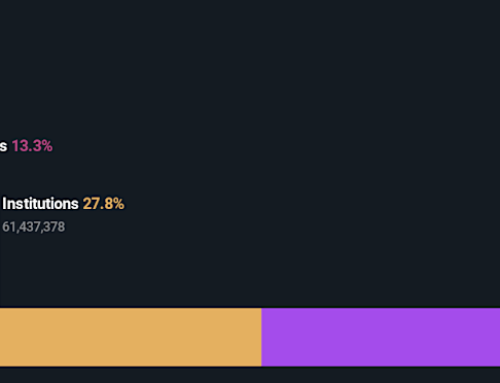Lynas Rare Earths Limited’s (ASX:LYC) institutional investors lost 4.3% last week but have
June 28, 2025
-
Significantly high institutional ownership implies Lynas Rare Earths’ stock price is sensitive to their trading actions
-
The top 8 shareholders own 50% of the company
If you want to know who really controls Lynas Rare Earths Limited (ASX:LYC), then you’ll have to look at the makeup of its share registry. And the group that holds the biggest piece of the pie are institutions with 57% ownership. In other words, the group stands to gain the most (or lose the most) from their investment into the company.
Losing money on investments is something no shareholder enjoys, least of all institutional investors who saw their holdings value drop by 4.3% last week. However, the 50% one-year return to shareholders might have softened the blow. But they would probably be wary of future losses.
Let’s delve deeper into each type of owner of Lynas Rare Earths, beginning with the chart below.
See our latest analysis for Lynas Rare Earths
Institutional investors commonly compare their own returns to the returns of a commonly followed index. So they generally do consider buying larger companies that are included in the relevant benchmark index.
As you can see, institutional investors have a fair amount of stake in Lynas Rare Earths. This suggests some credibility amongst professional investors. But we can’t rely on that fact alone since institutions make bad investments sometimes, just like everyone does. When multiple institutions own a stock, there’s always a risk that they are in a ‘crowded trade’. When such a trade goes wrong, multiple parties may compete to sell stock fast. This risk is higher in a company without a history of growth. You can see Lynas Rare Earths’ historic earnings and revenue below, but keep in mind there’s always more to the story.
Since institutional investors own more than half the issued stock, the board will likely have to pay attention to their preferences. Lynas Rare Earths is not owned by hedge funds. Australian Super Pty Ltd is currently the company’s largest shareholder with 9.5% of shares outstanding. For context, the second largest shareholder holds about 8.5% of the shares outstanding, followed by an ownership of 8.2% by the third-largest shareholder.
On further inspection, we found that more than half the company’s shares are owned by the top 8 shareholders, suggesting that the interests of the larger shareholders are balanced out to an extent by the smaller ones.
While it makes sense to study institutional ownership data for a company, it also makes sense to study analyst sentiments to know which way the wind is blowing. Quite a few analysts cover the stock, so you could look into forecast growth quite easily.
The definition of an insider can differ slightly between different countries, but members of the board of directors always count. The company management answer to the board and the latter should represent the interests of shareholders. Notably, sometimes top-level managers are on the board themselves.
Insider ownership is positive when it signals leadership are thinking like the true owners of the company. However, high insider ownership can also give immense power to a small group within the company. This can be negative in some circumstances.
Our information suggests that Lynas Rare Earths Limited insiders own under 1% of the company. However, it’s possible that insiders might have an indirect interest through a more complex structure. Keep in mind that it’s a big company, and the insiders own AU$33m worth of shares. The absolute value might be more important than the proportional share. It is good to see board members owning shares, but it might be worth checking if those insiders have been buying.
The general public, who are usually individual investors, hold a 31% stake in Lynas Rare Earths. While this size of ownership may not be enough to sway a policy decision in their favour, they can still make a collective impact on company policies.
We can see that Private Companies own 12%, of the shares on issue. It’s hard to draw any conclusions from this fact alone, so its worth looking into who owns those private companies. Sometimes insiders or other related parties have an interest in shares in a public company through a separate private company.
While it is well worth considering the different groups that own a company, there are other factors that are even more important. Case in point: We’ve spotted 3 warning signs for Lynas Rare Earths you should be aware of, and 1 of them is a bit unpleasant.
But ultimately it is the future, not the past, that will determine how well the owners of this business will do. Therefore we think it advisable to take a look at this free report showing whether analysts are predicting a brighter future.
NB: Figures in this article are calculated using data from the last twelve months, which refer to the 12-month period ending on the last date of the month the financial statement is dated. This may not be consistent with full year annual report figures.
Have feedback on this article? Concerned about the content? Get in touch with us directly. Alternatively, email editorial-team (at) simplywallst.com.
This article by Simply Wall St is general in nature. We provide commentary based on historical data and analyst forecasts only using an unbiased methodology and our articles are not intended to be financial advice. It does not constitute a recommendation to buy or sell any stock, and does not take account of your objectives, or your financial situation. We aim to bring you long-term focused analysis driven by fundamental data. Note that our analysis may not factor in the latest price-sensitive company announcements or qualitative material. Simply Wall St has no position in any stocks mentioned.
Terms and Privacy Policy
Search
RECENT PRESS RELEASES
Related Post




